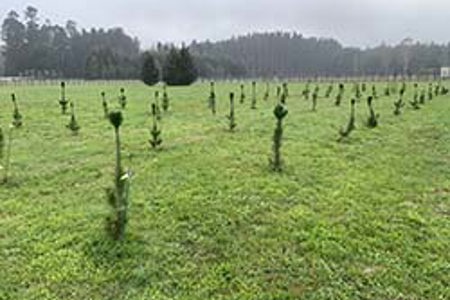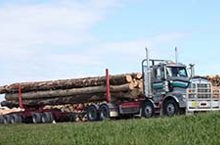
As part of research aimed at improving wood quality and producing materials to support New Zealand’s bioeconomy, Scion has launched the world’s first field trial of gene-edited conifer.
The Crown Research Institute has implemented the advanced gene-editing technique known as CRISPR that lets scientists turn off a specific gene within the pine’s complex genome. This helps them understand what that gene does – which in turn builds understanding of how wood develops.
Two sets of trees have been planted, each with a separate gene turned off. This aims to enhance timber quality and improve the process of converting wood into fibre and sustainable chemical feedstocks for the bioeconomy. One of these genes is involved in the synthesis of hemicellulose, a renewable biopolymer – a molecule produced by plants with many versatile, high-value applications. The other is involved in the development of compression wood, which forms on leaning or bent stems to straighten them up. We know compression wood behaves differently from normal wood during timber processing, leading to issues such as warping and reduced strength, as well as making the extraction of fibre and chemicals more difficult.
The trees in this trial were initially cultivated in a contained greenhouse, where their wood underwent a comprehensive analysis. This research yielded unique and fundamental insights into the mechanisms of cell wall formation. The trees have subsequently been planted in Scion’s Environment Protection Agency-approved GMO field test containment facility to help scientists better understand how they perform under real-world conditions and to collect sufficient wood for relevant biomechanical experiments.
Scion Senior Scientist, Glenn Thorlby, says the trees’ growth and development continue to be meticulously monitored: “This research will allow us to produce trees that, with optimised wood properties, will support the export of high-value timber and the biomass needed to replace petrochemicals as New Zealand transitions to a low-emissions sustainable bioeconomy.
“Additionally, Scion has developed gene-edited Douglas-fir to create sterile trees that could be planted without the risk of exacerbating New Zealand’s wilding pine issue. These sterile trees would potentially act as a form of biocontrol for future genetically modified trees.
“This will enable Douglas-fir to grow normally but not reproduce, helping limit its spread,” he says. “By targeting reproductive genes, we offer a potential solution to New Zealand’s wilding pine problem.”
Scion’s team is using advanced sequencing and analysis tools to pinpoint genes specifically involved in reproduction. Trees with these identified genes inactivated through gene editing have been developed and must now undergo field testing to confirm they grow normally but don’t produce the seeds responsible for spread.
Scion hopes to undertake these field trials when future regulations allow.
Alec Foster, Scion’s general manager for Forest to Biobased Products, highlighted the opportunity this work offers New Zealand: "This gene-editing achievement represents exactly the kind of transformative science New Zealand needs to secure its economic future.
“We're solving today's forestry challenges and pioneering solutions that could be worth billions to our economy. The ability to create sterile Douglas-fir trees that grow normally but can't spread as wilding pines, combined with radiata pine optimised for higher-value timber and biomanufacturing, demonstrates how gene technology can simultaneously protect our environment and drive economic growth,” he says.
“With the government's modernisation of gene technology laws, we're hopeful we will finally be positioned to translate this world-leading science into real-world outcomes that will benefit every New Zealander."









